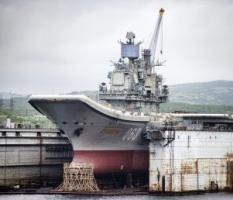
Photo: Flickr/Christopher Michel
This is an odd story, set in the icy Siberian waters near Murmansk, Russia. Apparently, Russia’s largest floating drydock sank from underneath Russia’s only aircraft carrier, the Admiral Kuznetsov, doing some damage to the carrier above the waterline as the dock sank. The carrier was undocking when a reported power failure caused the dock to flood and ultimately sink. Reportedly, one person died and four were injured.
The Sinking Floating Dry Dock
Here is where it gets odd. One account in the Drive blog suggests that Russia’s dry dock accident could have far larger repercussions than a damaged carrier. The drydock, designated PD-50, is the largest Russian floating dock and according to Drive the only Russian dry dock that we know of that could handle the country’s lone aircraft carrier.
On the other hand, the Diplomat blog says that shipyard reportedly possesses another floating dock, PD-1, of approximately identical size to the one sunk.
Which report is correct? Subsequent news accounts suggest that the PD-1 can handle every other Russian Navy ship except the Kuznetsov. There are also other reports that the Russians have large dry docks in the Black Sea and the Pacific, which may not be geographically convenient, but are nevertheless available if need be.
On the other hand, it is not clear to me why refloating a floating dry dock is that big a deal. Various sources say that it could take six months to a year. One complication is that the bottom near the shipyard is said to drop off quickly and one report says that the dock slid into water 160 feet deep.
Even if sitting in deep water, it is unclear to me why refloating the drydock is such a challenge. Floating dry docks are designed to partially sink and be refloated. A floating dry dock is nothing more or less than a strengthen barge with high extended wing-wall tanks. Provided that the drydock was not in some fashion ripped apart when it sank, it should be a matter of lining up valves and pumping air into the tanks to refloat the dock. That is what floating drydocks are designed to do. I may be missing something obvious and salvage is always more complicated than it appears. Nevertheless, this is not rocket science.
The Smokey Carrier with a Bad Heart
The United States has 11 large aircraft carriers with flight deck areas several times greater than all other nation’s navies carriers combined. If you include amphibious assault ships, which would be considered to be aircraft carriers in other navies of the world, the US carrier fleet increases to 20.
Russia, by comparison, has one — the Admiral Kuznetsov, and it is just barely hanging on. Ordered in 1981, commissioned in 1990 but not fully operational until 1995, the carrier is steam turbine powered and burns heavy fuel. Since it was delivered the ship has had chronic boiler problems. A Russian news article described the Kuznetsov as having a “weak heart.”
Between bad boiler tubes, combustion problems, and burning Mazut, a Russian version of Bunker C, the carrier is notorious for belching a vast cloud of black smoke whenever underway.
Beyond the oily smoke, the carrier’s operating history has been troubled. The ship has never been deployed for longer than six months and has famously been followed by oceangoing tugboats during all of its sea voyages in case the ship breaks down. There were reports that in a 2011 deployment, the U.S. Navy’s Sixth Fleet kept close by so it could rescue crew, in case the Admiral Kuznetsov happened to sink.
During a deployment to Syria in 2016 deployment, one MiG-29K/KUB multirole fighter crashed due to a faulty arresting wire. A Sukhoi Su-33 air superiority fighter also plunged into the Mediterranean Sea when an arresting cable snapped during the landing.”
Admiral Kuznetsov already had a reputation as a bad luck ship. Having a drydock sink beneath her is unlikely to dispell that notion.
Admiral Kuznetsov was scheduled to be out of service being overhauled until 2021. The loss of drydock PD-50 is expected to delay her redelivery, although by how much is uncertain.
Thanks to Steve Phelps for contributing to this post.

The subject of an astonishing tug rescue in 2015 in the Bay of Biscay.
https://www.news.com.au/technology/innovation/inventions/see-the-stomachchurning-tugboat-effort-to-take-a-russian-aircraft-carrier-under-tow/news-story/5dd0fc5c3d61dd6ad90a2df5387176c7
There are portable fire-tube boilers in the city burning 2 oil.
They all have propane tanks: for the pilot flame..
No smoke, land based boilers are allowed to smoke for 3 Three minutes..